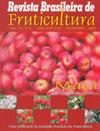Relationship among dry matter content and maturity indexes at harvest and quality of ‘Gala’ apples after storage
IF 0.9
4区 农林科学
Q4 HORTICULTURE
引用次数: 0
Abstract
Abstract The objective of this study was to determine the relationship among dry matter content (DMC) and maturity indexes at harvest and quality of ‘Gala’ apples after storage. Apple fruit of four ‘Gala’ strains produced on two rootstocks and three growing regions were used for experiments 1 and 2. For all experiments, fruit harvest maturity was assessed one day after harvest and stored fruit was assessed after removal from storage plus seven days at 22 °C. For experiment 1, fruit were harvested weekly along the final stages of growth and maturation on the tree. For experiment 2, fruit were harvested at commercial maturity and stored under a controlled atmosphere at 0.7 oC for 195 days. For experiment 3, fruit from two orchards were harvested at commercial maturity and stored in air at 1oC for 50, 110, or 194 days. DMC did not change during the final stages of fruit growth, however, there were significant changes in fruit firmness, starch index, and soluble solids content (SSC) during the same period. At the commercial harvest, fruit DMC showed high correlation with SSC, titratable acidity (TA) and firmness. DMC assessed at the commercial harvest also showed high correlation after storage with SSC and TA but not with firmness or flesh browning (FB). DMC decreased slightly during storage. The results show that DMC is not a reliable index to determine ‘Gala’ apple maturity at harvest, or to predict fruit firmness and FB after storage. However, DMC at harvest has potential to predict SSC and TA after storage, two important fruit quality traits. Fruit density at harvest showed utility to predict risk of flesh browning after storage.嘎拉苹果采后干物质含量、成熟度指标与贮藏后品质的关系
摘要本研究旨在研究嘎拉苹果采后干物质含量和成熟度指标与贮藏后品质的关系。试验1和试验2采用在2个砧木和3个种植区生产的4个‘Gala’品系的苹果果实。在所有实验中,果实在收获后1天进行成熟度评估,果实在22°C条件下储存7天后进行成熟度评估。在试验1中,果树在生长和成熟的最后阶段每周收获一次果实。在实验2中,水果在商业成熟时收获,在0.7℃的受控气氛下储存195天。在实验3中,两个果园的果实在商业成熟时收获,在10℃的空气中保存50天、110天或194天。DMC在果实生长后期没有变化,但果实硬度、淀粉指数和可溶性固形物含量(SSC)在同一时期发生了显著变化。在商品收获时,果实DMC与SSC、可滴定酸度(TA)和硬度呈高度相关。在商业收获时评估的DMC也显示贮藏后与SSC和TA高度相关,但与硬度和果肉褐变(FB)不相关。DMC在储存过程中略有下降。结果表明,DMC不能作为确定“Gala”苹果采收时成熟度的可靠指标,也不能作为预测果实硬度和贮藏后果厚的可靠指标。而收获时的DMC则有可能预测贮藏后的SSC和TA这两个重要的果实品质性状。收获时果实密度对贮藏后果肉褐变风险的预测具有实用价值。
本文章由计算机程序翻译,如有差异,请以英文原文为准。
求助全文
约1分钟内获得全文
求助全文
来源期刊
CiteScore
1.50
自引率
20.00%
发文量
34
审稿时长
4-8 weeks
期刊介绍:
The Revista Brasileira de Fruticultura (RBF) publishes technical articles and scientific communications in the area of fruit crops, referring to results of original searches and unpublished papers in Portuguese, Spanish or English, and 1 or 2 reviews per edition, of invited authors.

 求助内容:
求助内容: 应助结果提醒方式:
应助结果提醒方式:


